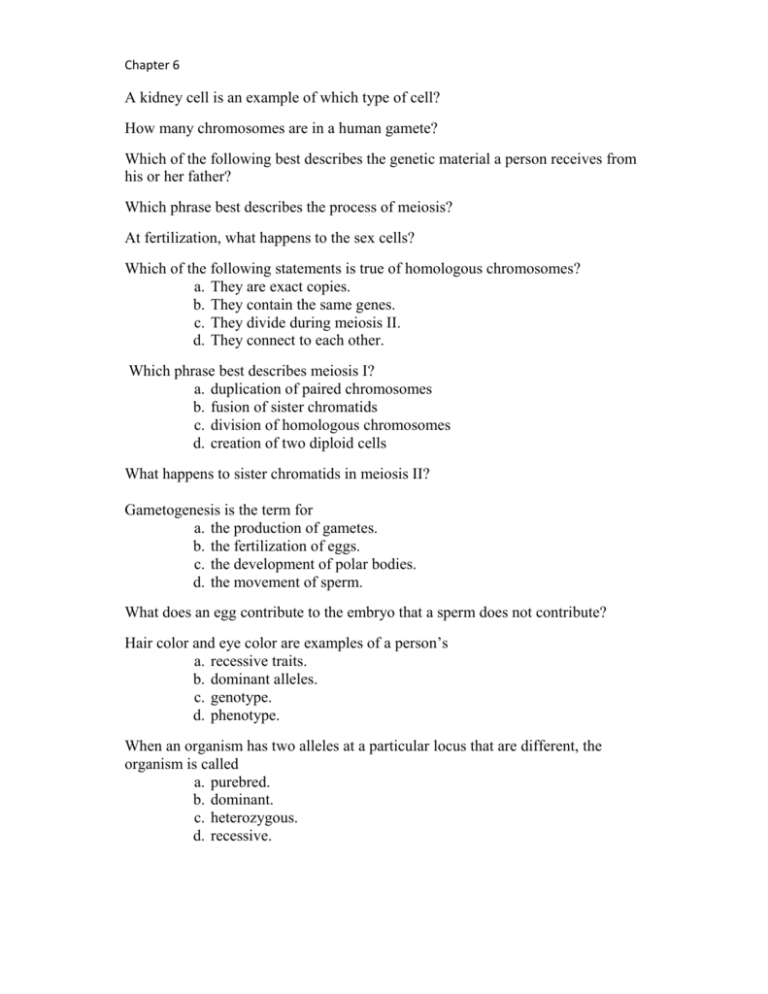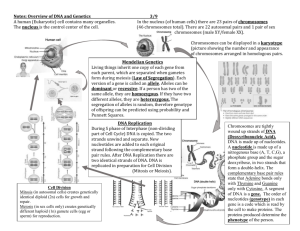Freshman Biology Midterm Study Guide
advertisement

Chapter 6 A kidney cell is an example of which type of cell? How many chromosomes are in a human gamete? Which of the following best describes the genetic material a person receives from his or her father? Which phrase best describes the process of meiosis? At fertilization, what happens to the sex cells? Which of the following statements is true of homologous chromosomes? a. They are exact copies. b. They contain the same genes. c. They divide during meiosis II. d. They connect to each other. Which phrase best describes meiosis I? a. duplication of paired chromosomes b. fusion of sister chromatids c. division of homologous chromosomes d. creation of two diploid cells What happens to sister chromatids in meiosis II? Gametogenesis is the term for a. the production of gametes. b. the fertilization of eggs. c. the development of polar bodies. d. the movement of sperm. What does an egg contribute to the embryo that a sperm does not contribute? Hair color and eye color are examples of a person’s a. recessive traits. b. dominant alleles. c. genotype. d. phenotype. When an organism has two alleles at a particular locus that are different, the organism is called a. purebred. b. dominant. c. heterozygous. d. recessive. Punnett Square 13. In the space provided list the genotypic traits and phenotypic traits shown in the Punnett Square. Genotypic traits:________________________________________________ Phenotypic traits:_______________________________________________ A a A Aa Aa Aa Aa a 14. In the space provide complete the Punnett Square below: A A A a 15. For the above Punnett Square, provide the genotypic and phenotypic ratio. Genotypic ratio:______________ Phenotypic ratio:_____________ Chapter 8 26. The main difference between the four nucleotides that make up DNA is that they have different a. sugars. b. uracil. c. bonds. d. bases. 27. Figure 8.1 shows a single strand of DNA. Choose the first three nucleotides of the other DNA strand. FIG. 8.1 a. b. c. d. GGT CCT GGC TTA 28. In humans, where does DNA replication take place? a. cytoplasm b. ribosome c. nucleus d. vacuole Chapter 9 29. Genetic engineering is possible because all organisms are based on the same a. proteins. b. DNA copies. c. plasmid loops. d. genetic code. 30. Scientists can study the effect of turning off a gene by using a. cloned animals. b. gene knockout organisms. c. DNA microarrays. d. DNA fingerprinting. 31. What is a clone? a. a genetically identical copy of a gene or organism b. a ring of bacterial DNA with foreign DNA inserted c. a mouse that has had some of its genes "turned off" d. a genetically engineered organism with new traits 32. Which of the following processes could a scientist use to make an amount of DNA that is large enough to study? a. polymerase chain reaction b. genetic engineering c. bioinformatics d. gel electrophoresis 33. In the restriction map shown in Figure9.1, which line, or band, represents the smallest DNA fragments? FIG. 9.1 a. A b.B c. C d.D 34. What goal of the Human Genome Project has been achieved? a. learning how DNA sequences vary b. sequencing all the base pairs of the human chromosomes c. understanding the function of each human gene d. discovering the proteins that play a part in cancer 35. Genetic screening can help determine a person’s risk of passing on a genetic disorder through a combination of family history and a. recombinant DNA. b. gene knockouts. c. DNA microarrays. d. DNA testing Short Answer Use the diagram below to answer items 16–20. (5 credits) FIG. 9.3 36. What is shown in Figure 9.3? _______________________________________________________________ 37. What is this type of DNA analysis used for? _______________________________________________________________ 38. What does each of the bands in the diagram represent? _______________________________________________________________ _______________________________________________________________ 39. The analysis of DNA shown in Figure 9.3 comes from a mother, a father, and their child. Could person 3 be the child? Explain. _______________________________________________________________ _______________________________________________________________ 40. Describe one way this type of DNA analysis is used in organisms other than humans. _______________________________________________________________ _______________________________________________________________ Freshman Biology Midterm Study Guide used. Chapter Test A, continued ____________________________________________ Use the diagram below to answer items 21–25. (5 credits) ____________________________________________ FIG. 9.4 41. Identify the structure in part 1 of Figure 9.4. Where is this structure found? ______________________________________________________________ 42. What role do restriction enzymes play in part 2 of the diagram? ______________________________________________________________ ______________________________________________________________ 43. What is the term for the structure in part 3 of the diagram? ______________________________________________________________ 44. Define the term transgenic. How is the process shown in Figure 9.4 used to produce transgenic plants? ______________________________________________________________ ______________________________________________________________ ______________________________________________________________ 45. Describe one way transgenic plants are









